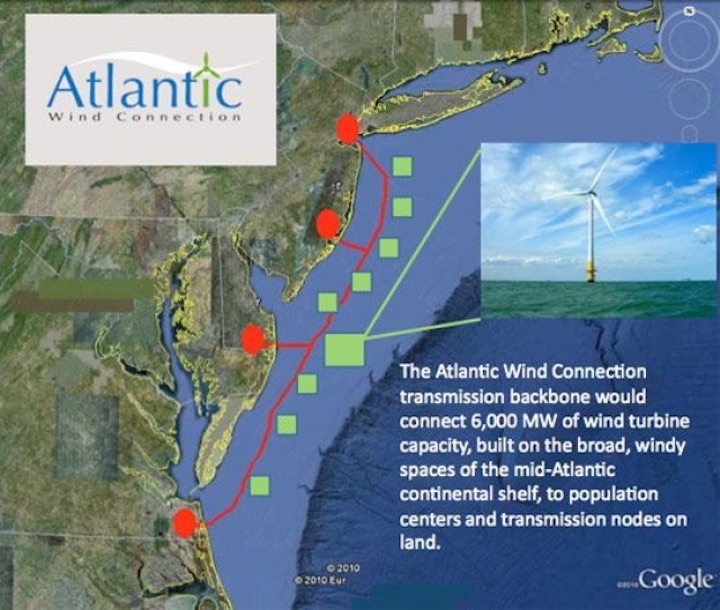Proposed floating wind farms off Northern California’s Humboldt Bay could generate power for the San Francisco Bay Area utilizing an underwater transmission line system extended over 250 miles and costing upwards of $3.1 billion, according to a Humboldt State University report.
The report was produced by the Schatz Energy Research Center at Humboldt State University, Arcata, California and is entitled “California North Coast Offshore Wind Studies: Subsea Transmission Cable Conceptual Assessment.”
In July, Adam Stern, executive director of the Menlo Park, CA-based trade association, Offshore Wind California, told AJOT that “progress has been made in the federal approval process” conducted by the Bureau of Ocean Energy Management (BOEM) so that auctions of offshore wind sites, “may begin in 2021.”
Three prospective offshore sites are:
- Morro Bay
- Diablo Canyon
- Humboldt Bay
In total, 11 companies applied for leases in both Diablo Canyon and Morro Bay off the Central California coast, while 10 applied for spaces off of Humboldt Bay in Northern California, according to BOEM.
Stern noted, “there is good transmission infrastructure at Morro Bay and at Diablo Canyon, but more limited transmission infrastructure at Humboldt Bay.”
The new wind farms could create economic development for California and for ports supporting assembly and manufacturing, he said.
The floating offshore wind platforms planned in California would be fastened to the ocean floor with cables and float on the surface of the sea. This reflects a next generation of technology and is necessary since California coastal waters are too deep to handle traditional shallow draft wind turbines built into the sea bed that are planned for the U.S. East Coast.
Stern said “there are 10 operational floating wind projects and 8 more due to be functioning by 2022.” He observed that auctions for offshore California sites only accord the developer the right to build a windfarm. There is still the challenge of permitting, finance, construction and logistical support.
East Coast Offshore Transmission Line
Stern said a major challenge for wind turbine developers, who are currently developing wind farm projects on the U.S. East Coast, is linking power generated by wind farms offshore to land-based transmission systems.
The proposed Atlantic Wind Connection (AWC), in which Google was an investor, planned to address this issue by building an offshore transmission line so as to link windfarms planned off the coasts of states between New Jersey and Virginia and connect them to land-based transmission systems.

Stern believes the project was ten years ahead of its time. If built today, the AWC could create a new transmission system as a back-up to older transmission systems as well as streamline the grid and transmission delivery for windfarms being developed along the East Coast.
Stern said building an AWC-type system for California would create a new transmission system, replace older land-based systems and improve delivery of offshore windfarm power.
The Humboldt State University report describes how such an offshore transmission line could be built off the U.S. Pacific coast but also outlines the challenges that need to be addressed.
Hazards and Constraints
The report warns: “The subsea study area between Humboldt Bay and SF Bay includes both natural and anthropogenic constraints and hazards with variable levels of risk. These hazards and constraints will require a combination of avoidance and mitigation measures to install a transmission cable between the two areas. “
Risks due to hazards and constraints are the following:
Hazards: “Deep subsea canyons extending from the nearshore area to depths below the continental shelf, where subsea landslides strong enough to rupture cables are common. – Seismic fault line surface displacements which may be too large to mitigate for. Cable repairs may be required with a major seismic event. – Some of the largest subsea sandwaves in the world are present outside the Golden Gate, which may preclude subsea transmission cable routing through the Golden Gate.”
Constraints: “Areas of exposed bedrock and other hard substrate are located within marine habitat areas where cable protection methods may be either expensive or not permitted by agencies. – Potential interferences with or damage from fishing activities if the cable is not able to be buried or otherwise protected – No power cables have been installed to the depths required to route offshore of the subsea canyons (over 9,000 feet deep), and proven cable technology has not yet been developed for installation at these depths. – The offshore route will likely require crossing telecommunication cables in very deep water (5,000 feet or greater), which will require permissions from the existing operators. Though telecommunication cables crossings at these depths are common, power/telecommunication cable crossings at this depth do not appear to have previously been attempted.”
Nearshore and Offshore Strategies
Based on the location and mitigation possibilities for the hazards and constraints, “two potential cable corridors have been developed: a “Nearshore” corridor, an “Offshore” corridor. Both corridors have significant challenges that would need to be overcome to install and operate an HVDC link, though the challenges may not be insurmountable. Further analysis may be conducted to refine the severity of these risks and to develop possible mitigation strategies.”
The construction cost of the system is estimated to be approximately $2.1 – 3.1 billion, depending on whether one or two cables are installed: “It is likely that a single pole pair (one cable bundle) would be able to meet the rating requirements of 1,800 megawatts (MW). Installing two cables along different routes would provide redundancy for the transmission system in the case one cable incurs a fault or is damaged but would come at an additional cost of approximately $1 billion. Should multiple transmission cables be required to support transmission of multiple offshore windfarms (greater than 1800 megawatts), separation of cable routes should be considered to reduce risk of cable damage due to the hazards identified.”

